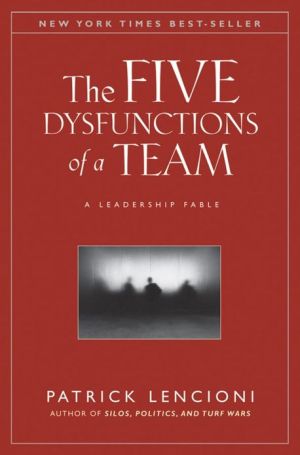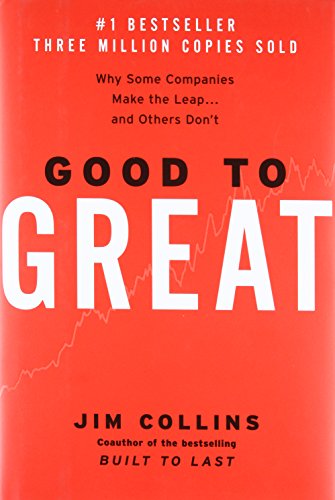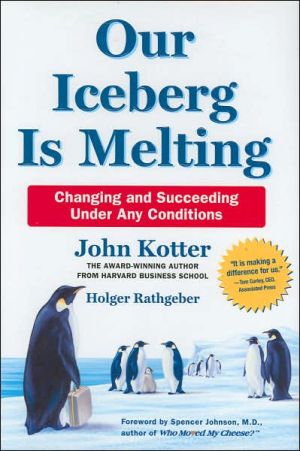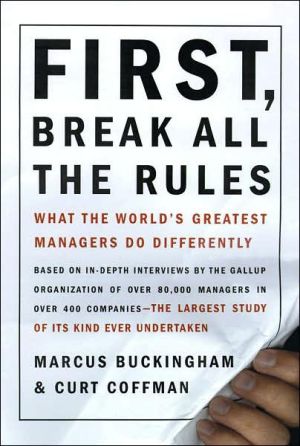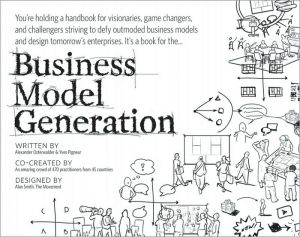The Five Dysfunctions of a Team: A Leadership Fable
Praise for Patrick Lencioni\ "A gripping analysis of what makes teams work effectively. This fine work is a must-read for any leader that has come to grips with the fact that no one makes progress–much less succeeds–alone."\ —James H. Amos Jr., president and CEO, Mail Boxes Etc.\ "Every manager and executive will recognize themselves somewhere in this book. Lencioni distills the problems that keep even the most talented teams from realizing their full potential. Even more important, he...
Search in google:
After her first two weeks observing the problems at DecisionTech, Kathryn Petersen, its new CEO, had more than a few moments when she wondered if she should have taken the job. But Kathryn knew there was little chance she would have turned it down. After all, retirement had made her antsy, and nothing excited her more than a challenge. What she could not have known when she accepted the job, however, was just how dysfunctional her team was, and how team members would challenge her in ways that no one ever had before.In The Five Dysfunctions of a Team, Patrick Lencioni once again offers a leadership fable that is as enthralling and instructive as his first two best-selling books, The Five Temptations of a CEO and The Four Obsessions of an Extraordinary Executive. This time, he turns his keen intellect and storytelling power to the fascinating, complex world of teams.Kathryn Petersen, DecisionTech’s CEO, faces the ultimate leadership crisis: uniting a team that is in such disarray that it threatens to bring down the entire company. Will she succeed? Will she be fired? Will the company fail? Lencioni’s riveting tale serves as a timeless reminder that leadership requires as much courage as it does insight.Throughout the story, Lencioni reveals the five dysfunctions that go to the very heart of why teams–even the best ones–often struggle. He outlines a powerful model and actionable steps that can be used to overcome these common hurdles and build a cohesive, effective team. Just as with his other books, Lencioni has written a compelling fable with a deceptively simple yet powerful message for all those who strive to be exceptional team leaders. Publishers Weekly In keeping with the parable style, Lencioni (The Five Temptations of a CEO) begins by telling the fable of a woman who, as CEO of a struggling Silicon Valley firm, took control of a dysfunctional executive committee and helped its members succeed as a team. Story time over, Lencioni offers explicit instructions for overcoming the human behavioral tendencies that he says corrupt teams (absence of trust, fear of conflict, lack of commitment, avoidance of accountability and inattention to results). Succinct yet sympathetic, this guide will be a boon for those struggling with the inherent difficulties of leading a group. Copyright 2002 Cahners Business Information.
Not finance. Not strategy. Not technology. It is teamwork that remains the ultimate competitive advantage, both because it is so powerful and so rare.\ A friend of mine, the founder of a company that grew to a billion dollars in annual revenue, best expressed the power of teamwork when he once told me, "If you could get all the people in an organization rowing in the same direction, you could dominate any industry, in any market, against any competition, at any time."\ Whenever I repeat that adage to a group of leaders, they immediately nod their heads, but in a desperate sort of way. They seem to grasp the truth of it while simultaneously surrendering to the impossibility of actually making it happen.\ And that is where the rarity of teamwork comes into play. For all the attention that it has received over the years from scholars, coaches, teachers, and the media, teamwork is as elusive as it has ever been within most organizations. The fact remains that teams, because they are made up of imperfect human beings, are inherently dysfunctional.\ But that is not to say that teamwork is doomed. Far from it. In fact, building a strong team is both possible and remarkably simple. But it is painfully difficult.\ That's right. Like so many other aspects of life, teamwork comes down to mastering a set of behaviors that are at once theoretically uncomplicated, but extremely difficult to put into practice day after day. Success comes only for those organizations that overcome the all-too-human behavioral tendencies that corrupt teams and breed dysfunctional politics within them.\ As it turns out, these principles apply to more than just teamwork. In fact, I stumbled on them somewhat by accident in my pursuit of a theory about leadership.\ A few years ago I wrote my first book, The Five Temptations of a CEO, about the behavioral pitfalls that plague leaders. In the course of working with my clients, I began to notice that some of them were "misusing" my theories in an effort to assess and improve the performance of their leadership teams -- and with success!\ And so it became apparent to me that the five temptations applied not only to individual leaders but, with a few modifications, to groups as well. And not just within corporations. Clergy, coaches, teachers, and others found that these principles applied in their worlds as much as they did in the executive suite of a multinational company. And that is how this book came to be.\ Like my other books, The Five Dysfunctions of a Team begins with a story written in the context of a realistic but fictional organization. I have found that this allows readers to learn more effectively by losing themselves in a story and by being able to relate to the characters. It also helps them understand how these principles can be applied in a nontheoretical, real-world environment, where the pace of work and the volume of daily distractions make even the simplest of tasks seem arduous.\ In order to help you apply the material in your own organization, a brief section following the story outlines the five dysfunctions in detail. That section also includes a self-assessment and suggested tools for overcoming the issues that might be plaguing your team. Finally, although this book is based on my work with CEOs and their executive teams, its theories are applicable for anyone interested in teamwork, whether they lead a small department within a company or are simply a member of a team that could use some improvement. Whatever the case may be, I sincerely hope it helps your team overcome its particular dysfunctions so that it can achieve more than individuals could ever imagine doing alone. That, after all, is the real power of teamwork.
IntroductionThe Fable1Luck3Part One: Underachievement5Part Two: Lighting the Fire27Part Three: Heavy Lifting115Part Four: Traction171The Model185An Overview of the Model187Team Assessment191Understanding and Overcoming the Five Dysfunctions195A Note About Time: Kathryn's Methods221A Special Tribute to Teamwork223Acknowledgments225About the Author229
\ From Barnes & NobleThe Barnes & Noble Review\ This informative book focuses on the problems and conflicts that often prevent teams from working together to achieve their stated goals. As he has done in works such as The Five Temptations of a CEO and The Four Obsessions of an Extraordinary Executive, Lencioni couches his insights in narrative form: This time, he focuses on a fictional high-tech Silicon Valley start-up that has much potential but is burden by executives whose egos seem to be constantly clashing. The board brings in a talented CEO, Kathryn Peterson, whose experience lies mainly in manufacturing. How she wins over her executive team, who are wary of her nontechnological background, is the crux of the book -- and we become flies on the wall in three very dramatic but realistic off-site meetings that Peterson conducts with her direct reports in order to deal with the company's chronic problems. \ After this fable, Lencioni provides a practical discussion of the methods Peterson used. The five dysfunctions of the title -- lack of trust, fear of conflict, unwillingness to commit, avoidance of accountability, and inattention to results -- are ones that many leaders will recognize, but few will know exactly how to fix. Although Peterson’s Yoda-like wisdom may seem unrealistic to some, the universality of the issues she confronts will ultimately win you over.\ This work is easily devoured in one sitting, and you may find yourself doing just that. Clearly, Lencioni’s fable and the ensuing discussion are drawn from his experience as the president of a Bay Area management consulting firm, but even not knowing that, you’ll appreciate the wisdom of his teachings. If you’re a member of a leadership team, this will prove to be an invaluable book. (Holly McGuire)\ Holly McGuire is a book editor and consultant based in Chicago, Illinois.\ \ \ \ \ \ Publishers WeeklyIn keeping with the parable style, Lencioni (The Five Temptations of a CEO) begins by telling the fable of a woman who, as CEO of a struggling Silicon Valley firm, took control of a dysfunctional executive committee and helped its members succeed as a team. Story time over, Lencioni offers explicit instructions for overcoming the human behavioral tendencies that he says corrupt teams (absence of trust, fear of conflict, lack of commitment, avoidance of accountability and inattention to results). Succinct yet sympathetic, this guide will be a boon for those struggling with the inherent difficulties of leading a group. Copyright 2002 Cahners Business Information.\ \ \ Library JournalBuilding a cohesive team is not complicated, declares Lencioni, president of his own management consulting firm and author of The Five Temptations of a CEO. Departing from the dry, theoretical writing of many management books, he presents his case in the context of a fictional organization, and in doing so succeeds at communicating his ideas. The story is about a female CEO who is hired to bring together a dysfunctional executive staff to work as a team in a company that just two years earlier had looked promising. The scenarios that follow are recognizable and can be applied anywhere teamwork is involved, whether it is a multinational company, a small department within a larger organization, or a sports team. The five dysfunctions discussed are absence of trust, fear of conflict, lack of commitment, avoidance of accountability, and inattention to results. At the end of the story, the main points are summarized, and clearly written suggestions and exercises are offered to help bring about change. Concise and easy to follow, this book is recommended for academic and public libraries with management collections and for anyone who is a member of a team that needs improvement. Bellinda Wise, Nassau Community Coll. Lib., Garden City, NY Copyright 2002 Cahners Business Information.\ \
